Before I begin, I’d like to take the time to introduce myself to Pitcher List fans and readers. My name is Kyle Horton and I’m a new contributor here at Pitcher List. Here’s a little bit about myself. I’m entering my final year at Quinnipiac University, where I play D1 college baseball. I have always had an interest in baseball analytics. On the field, I’m a lefty hitter and primarily an infielder. For most of my baseball career, I was a switch-hitter, but once I got to college the right side wasn’t working. So now that you know a little about who I am let’s jump into the important stuff.
Bryce Harper’s 2019 performance has been viewed under a microscope after signing his massive 13-year contract with the Philadelphia Phillies. So far Harper has come up short in meeting the high expectations placed by fans expecting him to lead the Phillies back into the playoffs for the first time since 2011. But Harper is far from a lost cause and has been doing his best lately to prove he’s worth the contract. Harper’s bat has come alive in the past four weeks and it could all be due to a physical adjustment he’s made at the plate.
The Change
Bryce Harper’s batting stance has looked like a work in progress throughout the season as its slowly and steadily been changing. It wasn’t a change he made overnight, but rather an adjustment made over the course of the first three months. If you’ve watched him hit on a night-to-night basis you may not even realize the difference, but if you compare his swings from now and April, the changes are much more obvious.
Here is Harper on Opening Day, March 28th striking out to Braves’ pitcher Julio Teheran. Notice the bat resting on his shoulder and then the hard weight shift backward prior to his leg lift.
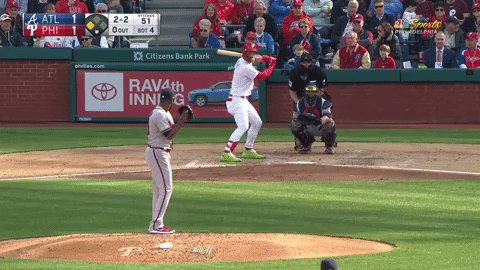
And here’s Harper on July 17th hitting a double off Clayton Kershaw:

He’s standing taller and more upright, his hands are higher and slightly tighter to his body, and his weight shift during his load is much quieter. We’ll get to why I believe these changes have made such a difference in his performance soon, but first let’s look at how his performance has improved.
The Result
Like I previously stated, Harper’s swing this season has been evolving over time. But at one point it stopped gradually changing and began to be repeated. This date would be June 21st. To the naked eye, June 21st is exactly the date where Harper made his final change to his stance by standing upright a bit more. Coincidentally or not, his production then began to takeoff. His splits before and after 6/21 are eye-popping:
| PA | AVG | OBP | SLG | OPS | wOBA | wRC+ | |
| Before | 322 | .243 | .357 | .452 | .809 | .341 | 110 |
| After | 94 | .308 | .426 | .564 | .990 | .410 | 155 |
His SLG and OPS have seen a jump of over .100 pts while his wOBA has gone from above average to excellent.
In this same period, Harper has cut his Pull% from 44.1% to 27.0% while increasing his Center% from 31.3% to 44.4%. Harper hasn’t had a problem hitting the ball hard this year, as he’s in the 89th percentile of all hitters in Average Exit Velocity, but after his change in stance he’s been able to maintain his Hard Hit % while decreasing his Soft Hit % from 12.8% to 9.5%. Although this doesn’t necessarily mean he is making more consistent hard contact, he is making less consistent soft contact which is definitely a good sign.
His spray charts show the same trend.
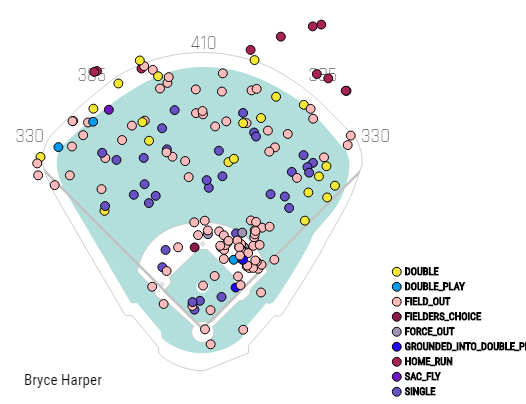
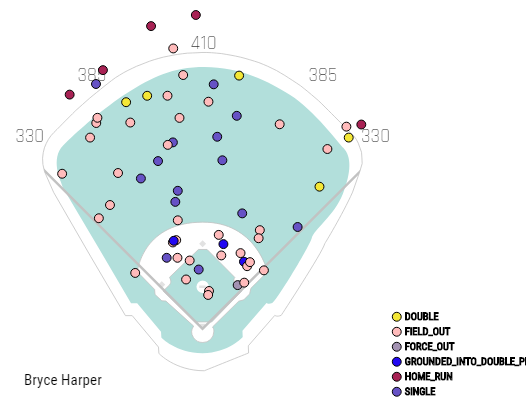
Before 6/21 After 6/21
Not to say he couldn’t spray the ball across the outfield before, but Harper is now utilizing the center and left side of the field more than his pull side. More specifically, he isn’t producing nearly as many ground balls to the right side of the infield.
Harper has also slightly decreased his swing and miss % from 16.8% to 15.0% of total pitches while increasing his contact % from 13.5% to 16.5% of total pitches. Take a look at the pitch results before and after the change. Keep in mind the visuals don’t chart pitches that are balls, so all data points are either called strikes or pitches that Harper has swung at.
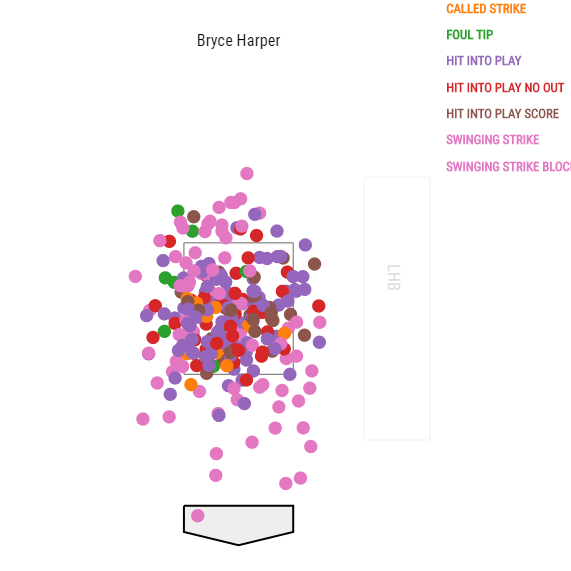
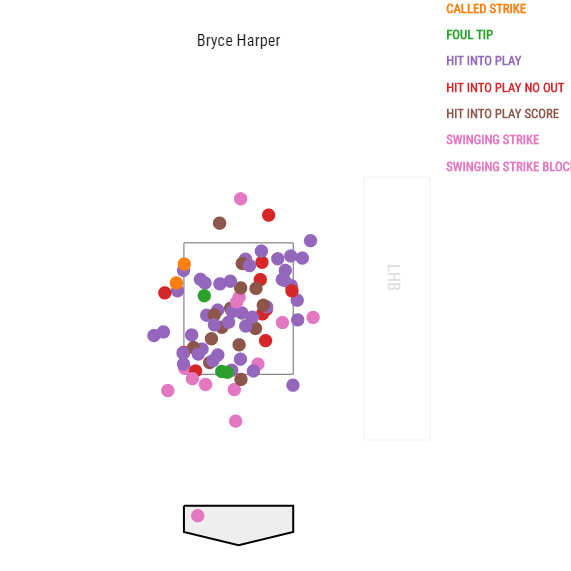
Before 6/21 After 6/21
Clearly, he’s swinging at fewer balls out of the zone. Perhaps the difference is just occurring because of the smaller sample size, but maybe Harper’s new swing really is having an impact.
The Effect
Some of you may choose to believe that Harper is just getting better luck and that the different stance isn’t playing a role in his performance. And maybe you’re right. The point is that it is too soon to tell if we are going to get an MVP caliber Harper for the rest of the season… or a player who doesn’t live up to the hype. But for those of you who want to believe that the adjustment IS the reason for success, let’s make some sense of it.
For starters, I am not a professional hitting coach nor am I trying to be. I’m a college baseball player with, what I believe to be, proficient enough swing knowledge that can potentially shed some light on what Harper might be trying to do. I won’t overanalyze it, and instead, just keep it simple and to the point. I’ll break the analysis into two components: timing and control. I believe these are two of the biggest factors in his turnaround.
Timing
Timing is a relatively easy swing concept for anyone to understand. Is the hitter on time for the pitch? The more consistent a hitter is with his timing the more consistent contact he will have. I think Harper’s improved timing comes directly from the new rhythm that he’s maintaining in his hands pre-pitch. Like Newton’s first law of motion says, an object in motion stays in motion. Maintaining rhythm and motion in his hands allows Harper to start his swing in a much more fluid manner. I would even go out as to say where he got this idea from.


Control
In this instance, when I say control I mean how well Harper controls his body into his swing. Harper, like most hitters, has a movement backward before he strides forward. However, the weight transfer in his old swing was much more dramatic than it is in the new one.

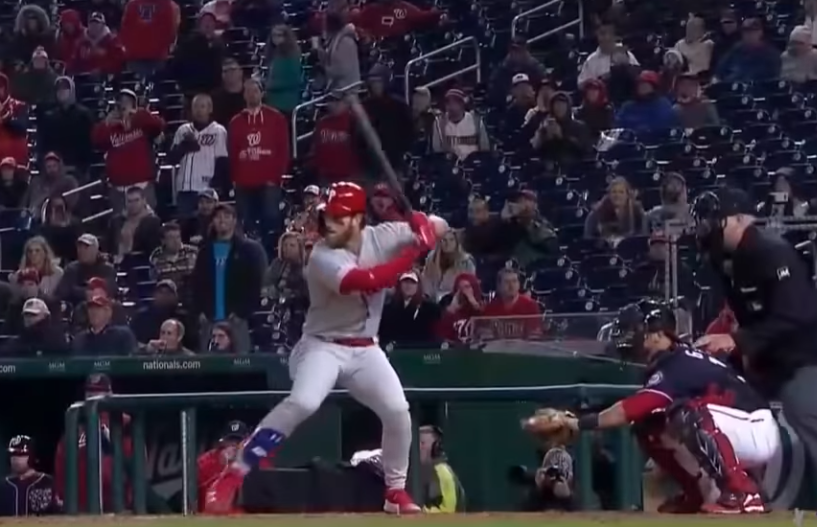
On the left, you have the new swing, on the right the old swing. Both swings are frozen right before the toe of the front foot comes off the ground, initiating the leg kick. In the old swing you can see how crouched down he is, almost like he’s sitting in a chair. But in the new swing, he looks much more upright and simple. As a result, his swing may be more controlled leading to improved consistency. How may this have an effect?
The most important part of every hitter’s swing, the make or break of mechanics, is the position they’re in when their front foot lands. This is when the actual rotation of the swing typically starts. The best position they can be in when their foot strikes down is one where their weight is about 50-50 distributed throughout their legs, their hands are back, and their head is center. Allow two of the best hitters in the game to demonstrate.

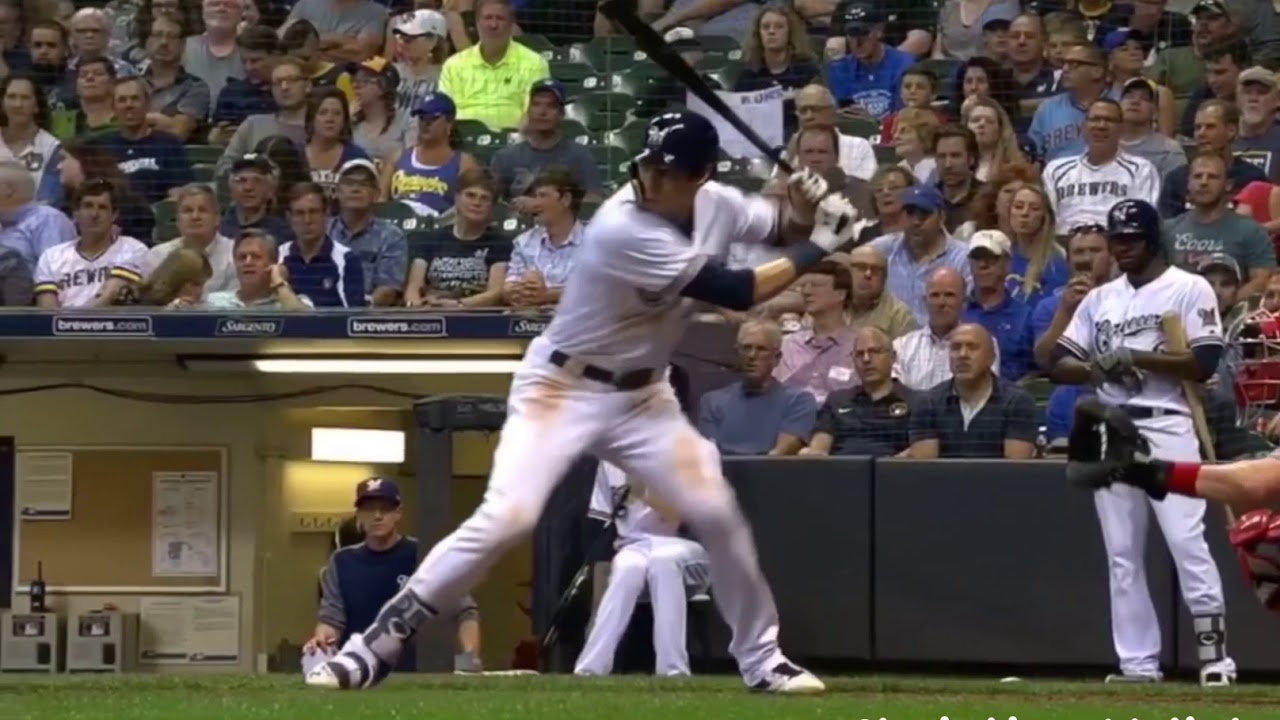
The common issue with too much weight shift prior to stride is that it makes it harder to get into this balanced position since more of your weight must go forward. For many hitters, if your weight isn’t becoming close to evenly distributed, your body will compensate in a number of ways. For Harper, I see this compensation coming from his upper body, where his shoulders take over the swing in an attempt to get his bat in the zone on time. However, it creates a longer swing and results in him looking like he’s “pulling off the ball”. Go look at the Teheran strikeout above and you’ll see what I mean (albeit it was a decent changeup).
The combination of better timing and control would theoretically allow Harper to stay on plane with specific pitches better than he previously would have. This improvement may be a possible explanation for the decrease in % of balls Harper has pulled, and an increase % of balls hit towards the center of the field. It could also lead to an increase in power which explains his large jump in SLG, as well as improve his plate discipline, showing the change in swing %. Again, it might just be a theory, but it isn’t unrealistic.
Moving Forward
My hitting analysis, or lack thereof, should not be the takeaway from this as it may just be conjecture and far from what Harper is really trying to do with his swing. But it is pretty obvious that there has been an adjustment made to Harper’s swing and there has definitely been an improvement in his production at the plate recently. His success and swing change may just be a coincidence, but there’s reason to believe it’s not just chance. As a former MVP and one of the game’s most talented hitters, Bryce Harper has more than enough ability to be able to garner success from a series of small changes. I guess we will have to just wait and see.
(Photo by Mark Goldman/Icon Sportswire)

Nice one.
Good article, but I wish all of your video examples would have come with all righties or lefties pitching and with the same pitch and the same count, for example Harpers approach to lefties has been better all season as he stays in with better balance and isn’t as prone to pulling off, and his 2 strike stance is totally different than his 0 or 1 strike stance, he usually spreads out more, less load, etc. So I can’t tell if some of the examples are just because of different counts and different handed pitchers, or if it really is a huge consistent difference from beginning of the season to now. If you watched tons of film I’m give you the benefit of the doubt as I just watch the games daily.
hardooo
David, I appreciate the feedback and you bring up a good point about the handedness of the pitcher. FWIW, Harper’s slashline vs LHP before the final change date was .267/.357/.547 and vs RHP .231/.357/.409. After the change date vs LHP (just 22 PAs) .286/.318/.429 and vs RHP .317/.450/.603. You’re right, throughout the season he has hit LHP better than RHP. I probably should have touched on this. As for the counts, you’re right that Harper has gone to a more “2 strike approach” stance at times but it isn’t a consistent change. He isn’t a Rizzo or Votto where he makes a visible change EVERY time he’s in a 2 strike count. For Harper it seems to depend on the leverage of the situation, he will change if it’s a situation where putting a ball in play is a must. If you watched the game yesterday, Harper hit a sacrifice fly off RHP Ross Striping in a 2-2 count in the first inning, his swing was the same as described in the article. Then he K’d in the fifth inning vs Stripling. His swing was the same. He then hit a game-tying double later off RHP Joe Kelly in an 0-1 count, where his swing was still the same. Although he may still change is stance to a “2 strike approach” from time to time, I think we will see the large majority of his swings being the new swing described, regardless of count and situation. But only time will tell us.
Nice article my boy
Great first article! Love the analysis!